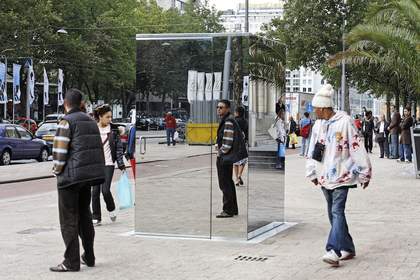
Monica Bonvicini’s Don’t Miss a Sec’ 2004, a stainless steel toilet unit inside a two-way mirror cubicle, installed in front of City Hall, Rotterdam, as part of IBC Rotterdam/Sculpture International, 2007
© Monica Bonvicini and VG-Bild Kunst, photo: Jannes Linders
Monica Bonvicini’s Don’t Miss A Sec’ 2004 consists of a functioning toilet inside a glass box, giving users an uninterrupted 360-degree view of the surroundings. The view is one-way, the pleasure one of covert surveillance rather than exposure. Apparently inspired by people’s reluctance to leave a gallery function for fear of missing out (later known as FOMO), Don’t Miss A Sec’ belongs to the dawning age of 24/7 connectivity – a period shaped both by the aftermath of 9/11 and an era of openness forged in the socially liberal 1990s, when the West perceived itself to be free from struggle and antagonism, as cultural theorist Renata Salecl observes in 2004’s On Anxiety.
War and conflict in the 1990s seemed comfortably remote and non-disruptive for much of Western society. There were few limits to self-creation, whether through the ‘just do it’ ethos of consumerism, or the culture of self-enhancement. As the text in the catalogue for the 1992 exhibition Post Human at the Deste Foundation in Athens claimed: ‘The matter-of-fact acceptance of one’s “natural” looks and one’s “natural” personality is being replaced by a growing sense that it is normal to reinvent oneself.’ Lingering anxieties were confronted in galleries that exposed what might once have been horrifying: the insides of animal and human bodies (Damien Hirst, Marc Quinn et al) and/or more personal revelations (Tracey Emin’s Everyone I Have Ever Slept With 1963–1995 1995). By such logic, 1997’s Sensation exhibition at the Royal Academy might have left us in a better place, like a cultural course of aversion therapy. But if it did so, the ideology of exposure has given rise to new forms of anxiety.
In the 2010s the psychological cost of total visibility is under scrutiny, as seen in a number of recent books and artworks. Take Hito Steyerl’s How Not to Be Seen 2013, which affects the tone of an instructional video with a computer-generated voiceover informing viewers how to remain invisible in an age of image proliferation (the best advice being to remain no larger than the size of a single pixel). Or Dave Eggers’s 2013 novel The Circle, in which he satirises the totalitarian consequences of a Google-inspired technocracy that peddles the ideal of sharing one’s entire life by ‘going transparent’. And Amalia Ulman’s Excellences & Perfections 2014–5, which takes the form of Instagram posts delivered to her tens of thousands of followers. Ulman’s online performance of body angst, break- ups, bad eatin’, bad thoughts and a boob job appears initially to chronicle the real emotional life of an aspirational cute girl until a final post reveals its artifice. Exposed throughout to a real-time social media commentary, it turns the 1990s explorations of identity construction by Cindy Sherman and Orlan into a far more anxious affair.
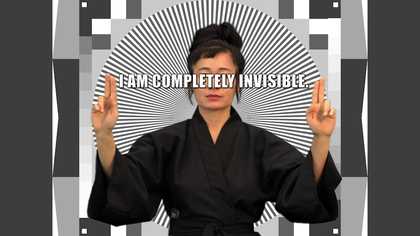
Hito Steyerl, still from How Not to Be Seen: A Fucking Didactic Educational .MOV File 2013, HD video, single screen in architectural environment, 15 minutes, 52 seconds
© Hito Steyerl, courtesy the artist and Andrew Kreps Gallery, New York
While social media amplifies anxieties in a public forum, giving rise to new forms of anxiety and antagonistic behaviour (FOMO, cyber-bullying, the initially fictional condition of video-physiognomic- dysphoria (VPD) or aversion to one’s online video image), and feeds new obsessions and related art forms, the concept of anxiety has been with us for centuries.
Unlike fear, which is a biological ‘fight or flight’ response to a present threat, anxiety is ‘fear without a definite object’, as the Danish philosopher Søren Kierkegaard established in 1844’s The Concept of Anxiety. Fear subsides when an external threat is no longer present, while anxiety festers internally but may latch on to objects in its path.
In a media age, this makes anxiety a powerful political vehicle, as revealed in creative documentary work after 9/11. Films such as Michael Moore’s Bowling for Columbine 2002 and Adam Curtis’s The Power of Nightmares 2004 and Bitter Lake 2015 investigate the production of scapegoats, demonstrating how anxiety is stoked and redirected through media imagery that gives solid form to the concept of invisible threat. The political imagery of the so-called ‘war on terror’ thereby functioned to close a loop; much as advertising creates an anxiety relievable by purchase, the hidden threat sells a particular form of solution.
In existential philosophy, anxiety is linked to the very process of self-creation. It arises not from constraint in the first instance, but from what Kierkegaard called ‘the dizziness of freedom’ – the simultaneously exhilarating and horrifying realisation that destiny is, to a greater or lesser extent, in one’s own hands. Historically, the rise of anxiety (as distinct from sheer misery) occurs in conditions of change and upheaval. In 1950’s The Meaning of Anxiety, the existential psychologist Rollo May linked this rise to mass migration in a period when many people left small towns and communities to find work in post-war cities. At the individual level, migration represents a literal and conceptual shift away from the world of certainties. Anxiety is the price of psychological autonomy; we feel ‘alive but alone’, says a character in WH Auden’s zeitgeist- naming poem The Age of Anxiety from 1948.
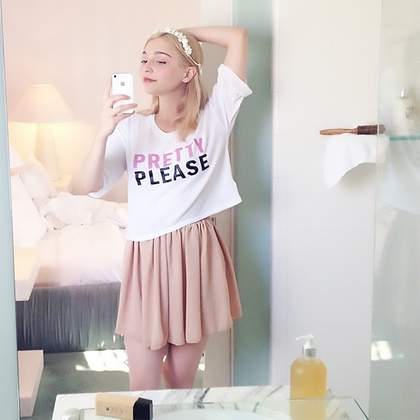
Instagram post made on 1 June 2014 as part of Amalia Ulman’s Excellences & Perfections 2014–15
Courtesy the artist and Arcadia Missa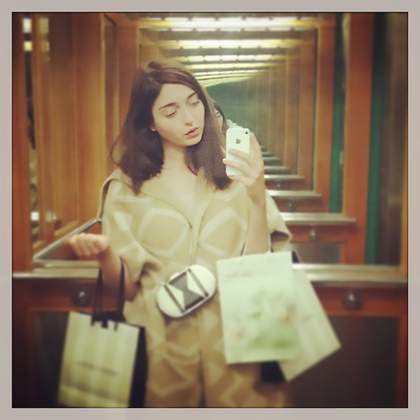
Instagram post made on 5 September 2014 as part of Amalia Ulman’s Excellences & Perfections 2014–15
Courtesy the artist and Arcadia Missa
It is this post-war age that May identifies as the point at which anxiety becomes overt – not only because it was a time of upheaval and hardship, but because the social structures that had impeded anxiety’s explicit expression began to break down. The struggle against traditional constraints was extensively manifested in the rise of youth subcultures from the mid-20th century. New identities were forged in a spirit of resistance towards conventional values, from the 1960s countercultural movement to the punk era of the 1970s. Subcultures did not disappear by the 1990s, but they were no longer odd minorities. Consumerism effectively embraced the postmodern idea that personal identity was a purchasing choice. And now, two decades later, body art and various means of body modification are well established in the mainstream.
As a consequence, to quote the title of a brilliant manifesto-style essay by the Institute for Precarious Consciousness, We Are All Very Anxious. Anxiety is now the dominant emotional experience of our time, precisely for this reason: anything and everything is on show, for sale and attainable, but (for too many people) perpetually withheld, out of reach. Whereas historically people were condemned to misery or boredom, anxiety becomes pervasive in conditions where free choice is unfettered, and yet at some level illusory.
Art is indispensable to exposing such illusion and the exclusions it perpetuates. Art can inhabit spaces that may be off-limits, as Bonvicini recently noted: ‘You are allowed to do anything as an artist, you can be blind, crazy, or dead serious… the question is really: can you ever expand the boundaries? Who defines them? Who determines them? Where are they actually?’
These fundamental questions open up the politics of lived psychological experience. If anxiety is intensified through a confluence of social, economic, technological and material forces, the question of boundary does not pertain to what and where an artist can be, but to the larger concern of how we shape and designate social spaces and accommodate or marginalise people within them.
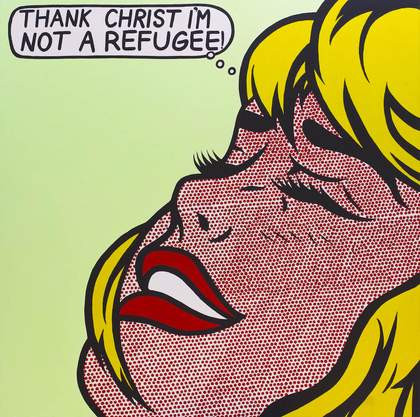
Richard Bell, Great Scott! 2014, acrylic paint on linen, 150 x 150 cm
Courtesy the artist and Milani Gallery, Brisbane, photo: Carl Warner
Anxiety in this context may begin to sound like a First World Problem (FWP): Instagram celebrities and impoverished shoppers, the self-obsessed products of consumerism whose vapid, detached emotions boil down to an internet meme. More specifically, it is an unevenly distributed problem of the First World, as the work of Indigenous Australian artist Richard Bell suggests. In Bell’s appropriations of Roy Lichtenstein, narcissistic quips reflect the vast gulf between indigenous and refugee lives and those of Europeans. As with Ulman’s Instagram posts, the persona here is a product of its medium, the archetypical trivial type. Self-indulgence is aptly parodied in the service of a bigger historical judgment.
But as Auden speculated, artists may be more conscious than most of an ‘inner disorder and dread’. The history of art is steeped in depictions of romanticised madness. Edvard Munch’s The Scream 1893–1910, for example, has become a default image for inner angst. However, in cultures with a mental health crisis of epidemic proportions, we have yet to produce the definitive exhibition forms and artworks that span both the subjective emotional and political-historical dimensions of anxiety and depression. Mental illness remains the ultimate stigma and challenge to representation. Even within art’s critical frameworks, subjective description risks a descent into self-absorption that threatens to cloud the big picture. The challenge is akin to the seemingly impossible assignment described in an ironic line at the end of David Foster Wallace’s 1998 short story The Depressed Person: ‘What terms might be used to describe and assess such a solipsistic self- consumed, bottomless emotional vacuum and sponge as she now appeared to herself to be?’ The impossibility of sharing pain is, as the story suggests, a contributing factor in its essential horror.
Visual art has more to do – not simply in documenting the range and extent of our anxieties, but in constructing the means for their relief. Foster Wallace once named ‘fiction, poetry, music’ as the arts through which the loneliness of mental illness may be ‘stared down, transfigured, treated’. Such big claims are more commonly made for both literature and music, perhaps because those forms can be experienced in private worlds. Books and music are a functional distraction from insomnia and pain, a means to quell rumination. More commonly an institutional experience, visual art does not seek to compete as cultural benzodiazepine.
But we have so far been too reticent in asserting art’s public role, too fearful that its aesthetic purpose may be burdened or compromised by a mission to transform public health. We may not yet have the language for this. But as the politics of identity and self-fabrication were core to art’s postmodern agenda, so the project of tackling anxiety begins.
